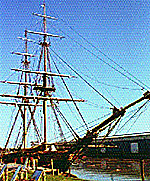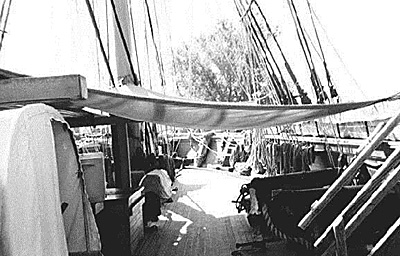 On September 10, 1813, Captain Oliver Hazard Perry won one of the most important American victories of the War of 1812 on the waters of Lake Erie. With naval control of the lake, the initiative in the area passed from the British to the Americans, and allowed Perry to carry General William Henry Harrison's army to the north shore.
On September 10, 1813, Captain Oliver Hazard Perry won one of the most important American victories of the War of 1812 on the waters of Lake Erie. With naval control of the lake, the initiative in the area passed from the British to the Americans, and allowed Perry to carry General William Henry Harrison's army to the north shore.
Then, on October 15, Harrison won his own major victory at the Thames River, and the focus of the war passed to other fronts further to the east. Perry's flagship was the twenty-gun brig Lawrence. But when it was severely damaged, he transferred his flag to its sister ship the Niagara. In time, the USS Niagara would become the flagship, with a history far longer than anyone could have expected. After the war, the ship was scuttled in Misery Bay. By all rights that should have been the end of its story.
Then in 1913, the Niagara was raised from the lake and hurriedly restored in time for the hundredth anniversary of the battle. It remained in this imperfect state until 1931, when the state of Pennsylvania took it in hand for a more extensive effort at the city of Erie, where it had been built in the first place. The Great Depression interfered so the final work on the masts and rigging was not finished until 1963.
The Niagara was sited on concrete supports on land near Erie's Public Dock, where it was a landmark for twenty-five years. Despite its historical significance and the work put into its restoration, the Niagara fell victim to forces far more damaging than British gunfire — apathy and neglect. The vessel decayed to the point that walking the top deck, the only one open to the public, was unsafe. Pennsylvania began the brig's rescue in 1988, finishing two years later. Though the finished vessel is officially a restoration of Perry's original, it is more properly a complete reconstruction. It is virtually an entirely new ship from the keel up, with the only early nineteenth-century timbers retained in hidden, nonstructural locations.
The result, regardless of how it might be termed, is far superior to the one that preceded it, even before its descent into forlorn dereliction. To begin with, the reborn Niagara is where it belongs — in the water. It has its own berth on the Erie waterfront, with a maritime center and library under construction adjacent. Moreover, the Niagara is, for the first time since it slid beneath the waters of Misery Bay, a working, functional ship. The rigging is much more elaborate than it was during the sorry years on concrete, as it is no longer just for show. It has an engine for maneuvering into and out of port, but its main motive power is its sails. A close look reveals that the Niagara also has some very modern sailing aids, such as a global positioning satellite navigation system and advanced fire-suppression equipment, as well as a hidden engine for maneuvering into and out of port. There are other differences as well.
 Reconstructed top deck of the USS Niagara
Reconstructed top deck of the USS Niagara
The two masts, once standing straight to resemble those of a larger warship, are now raked. Also, the paint scheme is now black and buff, ironically reminiscent of the Royal Navy's. In a concession to stability, the Niagara no longer carries a full complement of guns, as it did in its beached incarnation; just a few carronades and long cannons.
Public access to the vessel is also better than in the past. Formerly, a visitor paid the admission fee, walked around the top deck, took some photos, and left. Today not just the open area but much of the lower deck is open, and the ship has a staff of guides, mainly retirees, knowledgeable about the latest restoration and experienced with the operation of the Niagara. Also, there is a small core of professional tallship sailors who, assisted by amateur volunteers, take the ship out for day sails on Lake Erie, and longer voyages throughout the Great Lakes, St. Lawrence River, and East Coast. Sailing ship buffs, and anyone interested in naval history, would do well to visit the Niagara.
Unlike most historic vessels, it is not a static museum piece, but a ship that can still take to the water, much as it did over a hundred and eighty years ago, though in a much more peaceful context. One can only hope that it never again becomes the stepchild of American naval history.
Getting There
Erie, Pennsylvania is located at the junction of Interstates 90 and 79, connecting it to Cleveland, Buffalo, and Pittsburgh. It is roughly equidistant from all three, and can be reached from them in about two hours. The Niagara itself is in the east of the city, at the foot of Holland Street. The ship is closed from November through March. Furthermore, due to its extensive sailing schedule, visitors should verify that it will be in port by calling (814) 871-4596.
Back to Cry Havoc #19 Table of Contents
Back to Cry Havoc List of Issues
Back to MagWeb Master Magazine List
© Copyright 1999 by David W. Tschanz.
This article appears in MagWeb (Magazine Web) on the Internet World Wide Web. Other military history articles and gaming articles are available at http://www.magweb.com